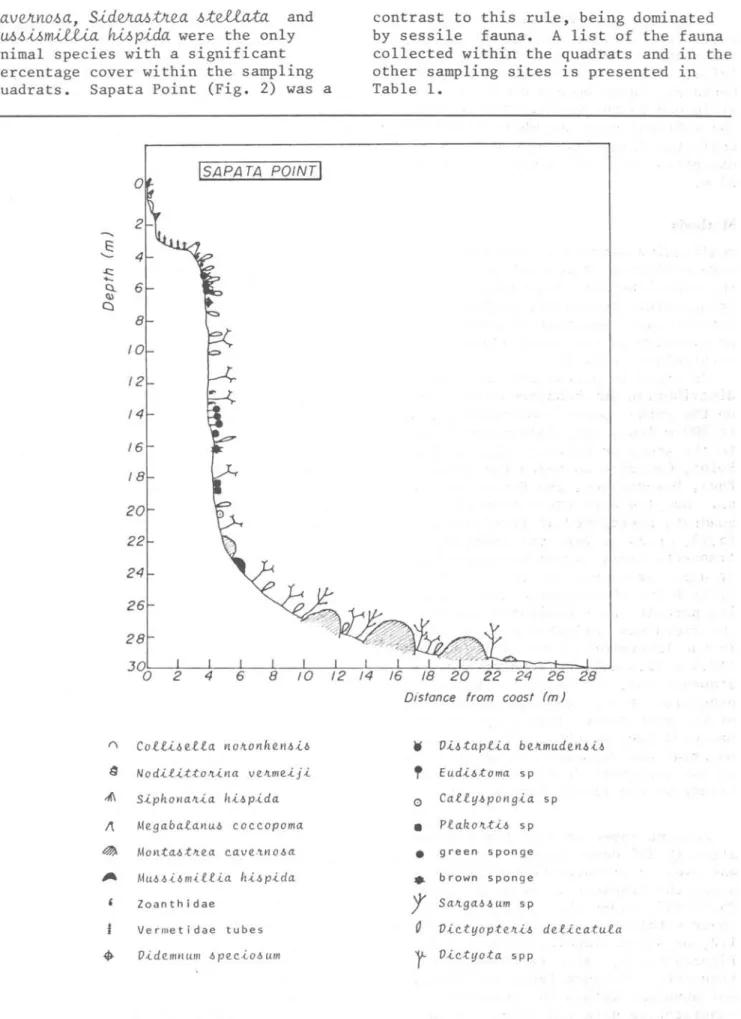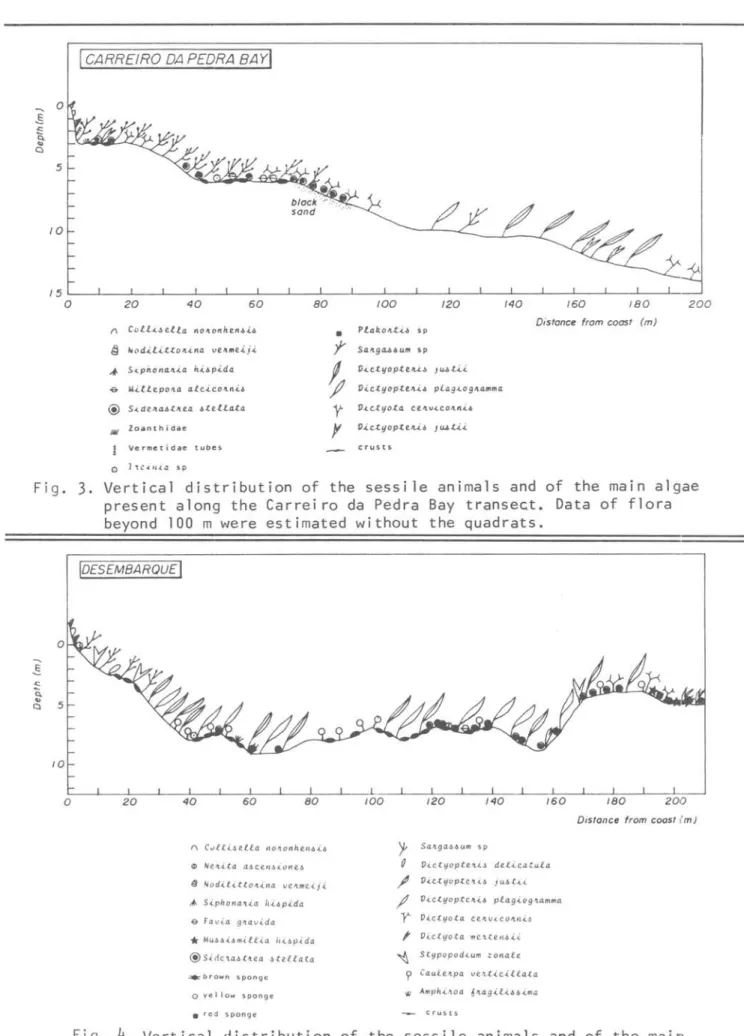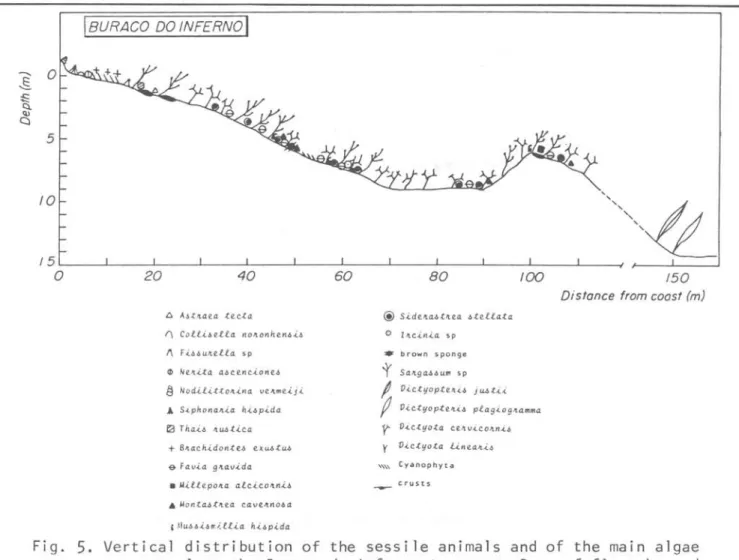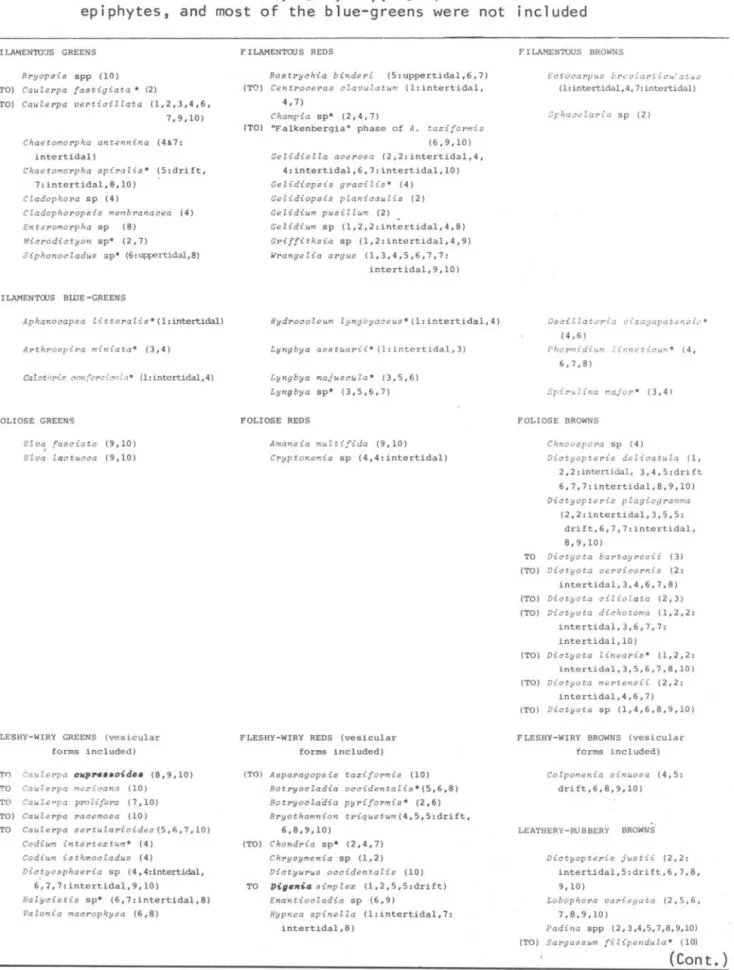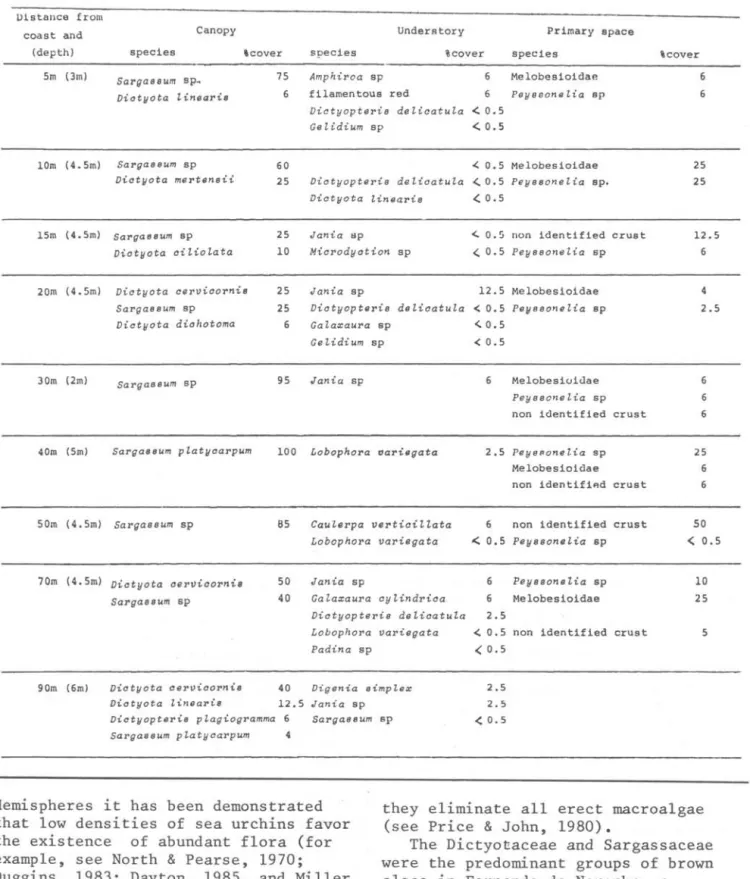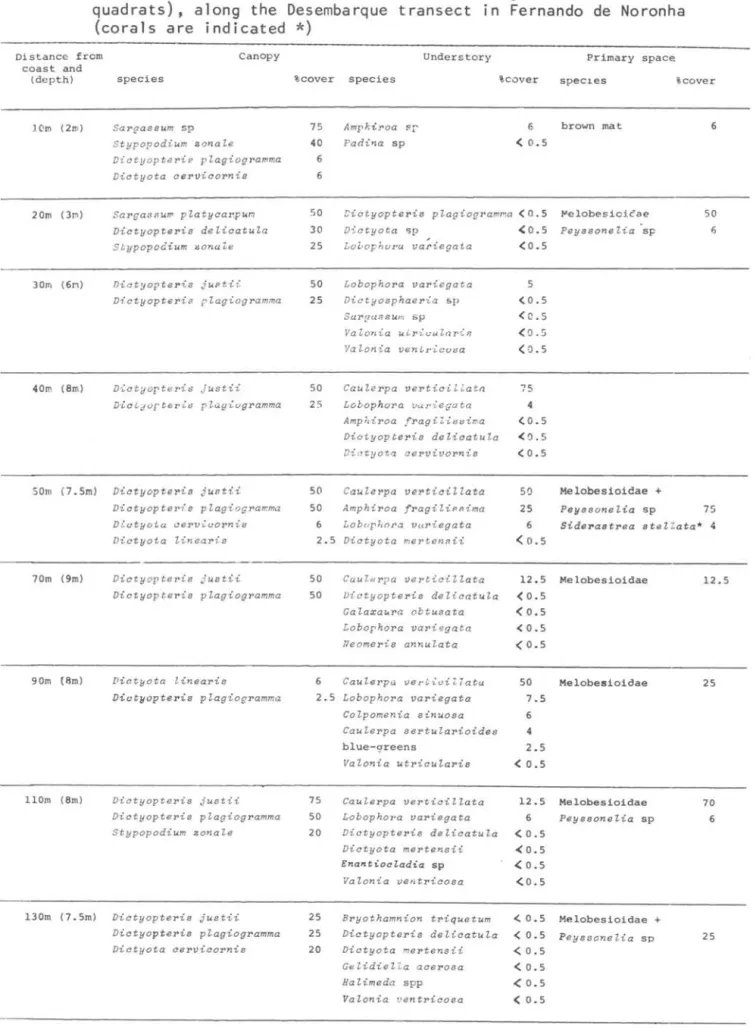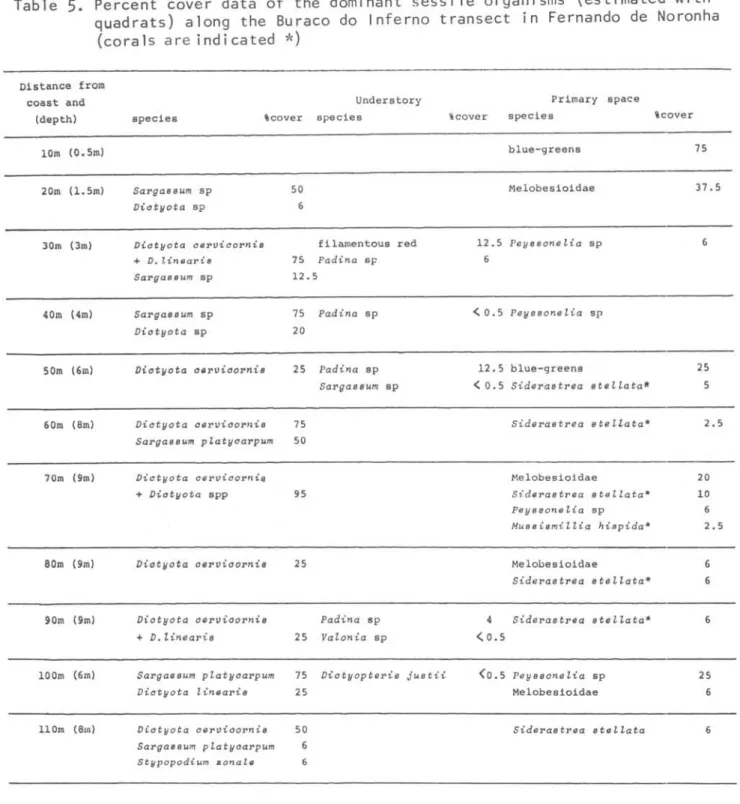Bolm Inst. oceanogr., S Paulo, 34(único) :37-53, 1986
VERTICAL DISTRIBUTION OF BENTHIC MARINE ORGANISMS ON ROCKY COASTS
OF THE FERNANDO DE NORONHA ARCHIPELAGO (BRAZIL)
Verena RappdeESTON1
*.
Alvaro Esteves MIGOTT02 ; Eurico Cabral de OLIVEIRA FILH02 ,3;Sergio de Almeida RODRIGUES2 ,3
&
José Carlos de FREITAS2 • 31 Instituto Oceanográfico da Universidade de são Paulo (Caixa Postal 9075, 01051
são Paulo, SP)
2 Centro de Biologia Marinha da Universidade de são Paulo (Caixa Postal 11461,
05421 são Paulo, SP)
3 Instituto de Biociências da Universidade de são Paulo (Caixa Postal 11461,
05421 são Paulo, SP)
Synopsis
Qualitative samples of flora and fauna were eolleated in several points~ jrom the
supralittoral fringe down to 30 m~ using mainly aqualungs. Speeies distribution
and abundanee were determined along four transeets~ up to 200 m long~ in seZeeted
plaees. Samples were taken from 25 x 25 em quadrats positioned at fixed intervals
along the transeets down to a variable depth~ depending on algal pereentage eover
and their substrate. The intertidal zone was populated essentiaUy by moUuscs.
The subtidal was covered predominantly by macroalgae. Mo~tnea cav~no~a,
S..i..d~Mtnea ~.te.U.a.ta and MUM~mil1...ia
wp..i..da
were the only animal species with a significant percentage cover with1.:n the quadrats. V..i..c.tyop.t~jM.t..i....i..,
V.
ptag..i..o-gJtCuna, V..i..c.tyota
c~v..i..coJt~,V.
UneaJÚ6,V. meJl.teMü,
SaJtgM~ump.ta.tycaJtpum,
SaJtgM~um sp" andS.typopod..i..um zonai.e
were the plants with the highest biomass and/or ,percentage cover~ along with Amp~oa óJtag~~..i..ma, Caut~pa v~cLela.ta,and crustose corallines. The scareity of sea urehins~ along with the dominance
of algae known to produce chemieal feeding deterrents or to have a calcareous
nature~ points towards a strong pressure by predators~ with fishes probably playing a key role in the maintenance of the structure of this subtidal community.
Descriptors: Benthic environment, Community composition; Check lists, Quantitative distribution, Vertical distribution, Oceanic archipelago, Nekton, Fernando de Noronha Archipelago: Brazil o
Descritores: Meio ambiente bentônico, Composição da comunidade, Lista das espécies, Distribuição quantitativa, Distribuição vertical, Arquipélago oceâni-co; Necton, Arquipélago de Fernando de Noronha: Brasil.
In troduction
The Archipelago of Fernando de Noronha ís located 360 km off the northeastern coast of Brazil. The main island is the site of a military base, andis inhabited by ca. 1200 people working as government employees or in touristic activities.
Its benthic marine organisms were first collected by the Challenger expedition, from 1873 to 1876 (see Fausto Filho, 1974, Oliveira Filho,
(*)
Pós-graduanda da área de oceanogra-fia biológica.Publ. n.
652 do In~.t.oceanogJt. da
U~p.1974). Ridley (1890) published the first taxonomic survey on the
crustaceans, molluscs. echinoids.
briozoans, and fishes ofthe Archipelago. Since that time, only taxonomic studies of the fauna have been undertaken, with the exception of the works of Laborel
(1969), Matthews
&
Kempf (1970), and of Fausto Filho (1974), which give the bathymetric distribution of corals, molluscs, and crustaceans, respectively. The only work dealing with the marine flora of the region was dane by Dickie(1874). After that, Pereira
e.t
ai..
(inprofiles of the flora of the region. As there is interest in increasing touristic activities in the archipelago, on one hand, and a popular movement·to preserve its marine flora and fauna, on the other, the knowledge of the biota is a must. This motivated us to make a survey of the region to get preliminary information on the quali-quantitative composition of the flora and fauna of its rocky coasts, especially of the sublittoral. This paper deals with the general characteristics and vertical distribution of these benthic marine organisms.
Study site
The Archipelago of Fernando de Noronha belongs to a branch of the mid-Atlantic Ridge (Almeida, 1955), and is composed of six small volcanic islands and 14 islets. The main island is about 9 x 6 km, oriented in a NE - SW direction (Fig. 1). It emerges at 03°5l'S and 32°25'W, rece1v1ng the
clear, warm (26-27°C), and quite saline waters (36%0) of the South Equatorial
Current (see Düi~g
et
al.,
1980). TheArchipelago is probably und~r the effect
of the Atlantic Equatorial Undercurrent, which originates off the northeastern Brazilian coast and flows below and in the opposite directibn of the South Equatorial Current, along the Equator between 50S and 5°N, at a depth of 60-90 m (Philander, 1973; Molinari
et
al.,
1981).During most of the year, ·southeast trade winds reach the southeas t e rn side of the archipelago, which is, therefore, subject to strong waves. The climate is tro"pical, with a dry season from August to January, and a wet period in the other months. Annual rainfall indexes reach 1083 mm, and mean air temperature
is 25.3°C (Walter
& Leith, 1960). There
are few fresh-water streams in the archipelago, which remain dry during most of the year (Almeida, 1955).
32028' 32°26 ' 32°24' 32022' W
r---=~::..::..---...::...:
....
- - - r _ - - - _ _ . , O J 0 4 8 ' SQ) SAPATA POINT @ DESEMBAROUE
® CARREIRO 011 PEDRA BAY 0 BURACO DO INFERNO
<J) DOIS IRMÃOS ® LAGOA
0 I
® CHANNELOFTHE CABELJ.CJA ISLANO
BOLDRO
@ SANTO ANTONIO BAY @ SUESTE BAY
r \
r--T--+-~ ~ ~4+~~~---t----~~~~~----~-f~~~---~-_- . ---403°50'
~OO
Ot.
~~",r>
O~O
r>-~O
,S\... ( I
o
".
\ l
~~r>-I---+- -.+--:::f-- --
r
t.
- - - --t---\:---f---f---j---lOJO 52'I a~ o Z 3Km
---L---~---~----~---~---~OJ054·
ESTON et
ai.:
benthic marine organisms: Fernando de Noronha 39Tides are semi-diurnal, with an amplitude of 3.2 m during the spring tides and 2.0 m in neap tides (Almeida, 1955). Smooth descending slopes, with boulders large enough not to b e
dislodged by the waves, compose most of the subtida1 seascape where samples were collected(Fig. 1). Sapata Point was an exception, with its steep slope down to 27 m.
Methods
Qualitative samples of flora and fauna were collected in several points, from the supralittoral fringe down to 30 m, using mainly aqualungs, during late October-early November of 1985, to get an overview of the biota around the archipelago (Fig. 1).
In order to assess the vertical distribution and abundance of the species on the rocky coasts four transects, up to 200 m long, were laid perpendicularly to the shore in selected places: Sapata Point, Carreiro da Pedra Bay (Golfinhos Bay), Desembarque, and Buraco do Infer-no. Samples were taken from 25 x 25 cm quadrats positioned at fixed places
(5,10, or 20 m) interval along the
transects down to a variable depth depending of algal abundance and their substrate. After being photographed and having its percent cover estimated visually, the flora was collected and sorted out in the laboratory. Four smaller quadrats (12.5 x 12.5 cm), placed within the standard one, were used to increase the precision of the cover data. The biomass of the most common fleshy species was measured (wet weight). The collected material was deposited in the herbarium
of the Instituto de Bioci~ncias,
Univer-sidade de são Paulo, Brazil (SPF).
Percent cover data of the dominant
algae (> 25% cover within each quadrat)
was used to picture their distribution along the transects. Algae prese"nt wi th
25 r- 50%, 50 ~ 75% and 75 ~ 100%
cover within the quadrats were drawn as
1,2, or 3 individuaIs, respectively, ~n
Figures 2 to 5, which represent the transects. Because fauna was usually not abundant within the quadrats, its quantitative data was based on the observation of its occurrence along the entire transect. Identification of the fishes was based on photographs.
Results
Most of the observations described below concern the northwestern side of the Archipelago, once the strong waves did not permit satisfactory work on the other side. The vertical distribution of the benthic marine organisms along the four transects studied is
illustrated in Figures 2-5.
The intertidal zone was essentially
populated by the gastropods
Noditittohi-na vvr..múj i, CoLt.ú.. ell.a nOJc..onhe.nó..L6,
Ne.-wa
a.óce.nóion..L6 de.twr.pe.nó..L6,
andSipho-nahia húpida,
and by the crabGJtap6M
gJtap6U6
(Table 1).N. vvr..múji
andN.
a.óce.Yl.6ion..L6 reached the highest posi tion in the shore, present from the supra-li ttoral fringe to the lower levei of the
midlittoral; together with
C.
nOJto-nhe.nó..L6
andS.
h..L6pida,
these snailsformed dense populations in the
midlittoral zone.
C.
noJtonhe.nó..L6
andN.
a.óce.nóion..L6
were special1y abundantin the exposed sites. Large portions of the intertidal substrate were often devoid of macroorganisms, being apparently nakeo. Algae, such as blue-greens, calcareous crusts, and Bo~.tJtychia
binde.hi
(Table 2) were occasionally present in the intertidalzone. The molluscs Th~
JtM.tica
andLe.u.cozonia
na.ó~a were observed mainlybetween the lower intertidal and the infralittoral fringe, a region usually characterized by red Melobesioidae
algae, vermetids
(Ve.ndJtopoma iJtJte.gulaJte.
and
Pe.taloconchM
vahiaYl.6) andBJtachi-don;tu e.XMtM.
The vermetids wereisolated or forming small concretions, rarely constituting reefs. Boldro Beach was an exception, where there was a Vermetidae/Melobesioidae reef platform on the infralittoral fringe. This reef formation sheltered in crevices and pools a more varied fauna, composed, for
instance, of
Le.u.cozonia ocell.ata,
Colum-bell.a me.JtcatoJÚa, A6tJtae.a te.da, ConM
Jte.giM, Eu.udaJÚ6 .tJtibuloidu,
F..L6~u.Jte.{{a
sPP? zoanthids, and pagurids.c.aveJtn.o.óa, SideJta.ótJtea .ó;teUata and MUó.ói.ómiUia hi.ópida were the only animal species with a significant percentage cover within the sampling quadrats. Sapata Point (Fig. 2) was a
[SAPA TA POINTI
E: ' -.s:::: ...
Cl. 6
<1l C)
8
lO
12
14
16
18
20
22
24
26
28
J%
S Nod-i.e-ittolt-ina ve.ltme.-ij-i
~ S-iphonalt-ia h-i-6p-ida
~ Me.gaba.eanu~ coccopoma
~ Monta-6tlte.a cave. .'lYlO-6a
Zoanthidae
Vermetidae tubes
• V.i.de.mnum -6pe.c-io-6um
contrast to this rule, . being dominated by sessile fauna. A list of the fauna collected within the quadrats and 1n the other sampling sites is presented 1n
Table 1.
Dis!once from coas! (m)
W VütapUa b e.ltmude.Yl~ Ü
"
Eud,ütoma sp0 CaU·if-6 pOYl g.i.a sp
•
p.eakolttü sp•
green sponge•
brown sponget
Saltga-6-6um spO VÜ.tyopte.ltü de.U.catu.ea
r
V-ictifota sppESTON
e.t
ai.
benthic marine organisms: Fernando de NoronhaI
CARREIRO DA PEDRA BAylª
Nod.i..l.i..ttOIl.ina ve."",e..i.j.<.~ S.ipnonall.i..a h.i.bp.i.da
-& Mi..lle.pOIL4 alc..i.c.oJln.ib
@ S ... deJtadtJtea oteU.ata
lIiI Zoantnidae Vermetidae tube!.
o 1 'tC.(H.{a sp
•
y
~
f]I
P!a~oJttü sp Distonce from coost (m)
Sa."Lga..4b"m sp
V<.~tyoptvt.Ü JIU.t.i~
V<.~tyopteJtü pia.g.(.ogJla.",m4
v ... ~tyota ce.Jlv.i.c.olllt .. il.
V.i~tyopte""'o J w.ti.i
crusts
Fig.
3.
Vertical distribution of the sessile animaIs and of the main algaepresent along the Carreiro da Pedra Bay transect. Data of flora beyond 100 m were estimated without the quadrats.
<:
Q.
..
Cl
/0
o
IDES EMBARQUE
I
20 40 60 80
~ Ne.llita a6Ce'ja.ione.6
§ Nodilittoll.in4 vellme.iji
JI:. S.iphonaJt.i.a h.i.óp.ida
G Favia 9Jtav.i..da
*
MU6b.i.6millia It.i6pida@S.it1c'tabt1tea. -6tell.ata.
.-.brown sponge
o yellow sponge • red sponge
/00 /20 /40 /60 /80 200
Distonce from coost I m)
't
Salt9a~6Url1 spg V.ic.tyopt.e'L,(,~ dei.i..ca..tuia
/
D.ic..tyopt.eJt.i& jU6t..i...i..j1 V.ictyoptCIl.(.1l pla.g.(.ogJtamma.
-y- V.ict.yo.ta c.e.1t V.(COItIl.i~ ; V.i..ctyota mC .. 'I.,(€'tl6.i.i ~ St.ypopod.(.um ZOl1ate
I' (auie.Jtpa ve .. 'I.t.icLltata.
_ crusts
Fig. 4. Vertical distribution of the sessile animaIs and of the main algae present along the Desembarque transect.
5
/0
I
BURACO DO INFERNOI
20 40
II A.6.tllaea .tecia
1\ F.i..~hulLe.lta sp
ê NodilittolLina veltmeiji
A S~phona~ia hiopida 1:3 Thaü ~UOÜca
+ Bltach.idonte..ó e.l:LL6,tiU 9-Favi..a 91tavida
• Millepolla alcicoltni~
• Montahtltea cavelLnoha
60 80
. . brown sponge
t
SalLga.6hUm sp/00
I..
V.i.ctyop.te.It.i..s j u.Jt.i...i.f1
V.i.ctyopte.lti...s plagi..ogltammar
V.i.c,{yota CVlv.i.colLn.t.óV.i.c.tyota tinealL.i.ó
"\\ Cyanophyta
crusts
/50 Distance from coast (m)
Fig.
5.
Vertical distribution of the sessile animaIs and of the main algaepresent along the Buraco do Inferno transect. Data of flora beyond 110 m were estimated without the quadrats.
The most common species of macroalgae around the archipelago are listed in Table 2, which does not include small filaments, tiny epiphytes, and many of the blue-greens. Brown algae of the families Dictyotaceae (Victyopt~
jlL6.t.ü. V. Y.JfagiogJtamma, Victyota
c.eJL-vic.oJtvú-6, V. uvteaJti-6, V. meJt;tevt-6ü,
Stypopodium zovtafe) and Sargassaceae
(SMgM -6um p!CLtyC.Mpum and SMgM-6um sp)
were dominant in terms of biomass and/or
percent cover, along with CaufeJLpa
veJtti~ata (Caulerpaceae), AmphiJtoa 6Jtag~-6ima (Corallinaceae), and crus tose corallines (Table 3-6, Figs 2-5). Desembarque (Fig. 4, TabJ.e 4) presented the highest algal diversity among the transects studied. Victyop~e
~ spp. normally occurred deeper than
SMgM-6um spp. Hafodufe wJtigh:tü. was the
only species of Magnoliophyta found, observed at Sueste Bay.
Sea urchins were scarce. Only one specimen of TJtipvtelLÓte-6 vevttJtic.o-6lL6, and
a few Euc.idaJti-6 tJtibufoide~ and Viadema
a~Mum Mc.evt-6iovU.6 were seen.
Fishes, on the other hand, were abundant; the most common species
observed during the dives are listed in Table 7. Large pelagic carnivores, such as sharks, barracudas, and dolphins were also presente A large population of
dolphins (Stevteffa fOvtgiJtO-6~), that
remained for long periods at Carreiro da Pedra Bay, was remarkable. Only one
specimen of CheioMa nlydM, a herbivorous
sea turtle, was seen at Desembarque.
Discussion
A striking feature of the Fernando de Noronha northwestern shores was the
simplicity of the littoral zone, in terms of species diversity and zonation.
The supralittoral fringe and the midlittoral zone were dominated by gastropods that showed wide vertical ranges when c.ompared to their mainland
equivalents. No~oJtivta uvteolata
(:= U;ttoJtúl.a zic.zac. bJta-6iUevt-6i-6 J (see
ESTON et
al.:
benthic marine organisms: Fernando de Noronha 43Tab1e 1. Macrofauna species co11ected in the Fernando de Noronha Archipe1ago, arúmged according to the samp1ing stations: (1) Sapata Point; (2)
Carrei ro da Pedra Bay; (3) Dois Irmãos; (4) Bo1dró; (5) Santo Antonio
Bay; (6) Desembarque; (7) Buraco do Inferno; (8) Lagoa;, 19) Channe1
of the Cabeluda Is1and and (10) Sueste Bay. Obs: C
=
common;U
=
uncommon;*
=
main1y intertiáa1; + intertida1 and subtida1;without any mark
=
main1y subtida1CLASSES AND SPECIES
DEHOSPONGIAE
CaLlyspongia sp Che lonaphysi I La sp
Pl.akortis sp lroainia sp
Spongia sp Irgernella sp HYDROZOA
Eudendl'ium sp
Halocol'dllle disticha
Mi llepol'Q a lcicornis
ANTHOZOA
Zoanthus sp
Palythoa sp
Agal'icia agaricites
Favia gl'alJida Montl'Qstea catlernosa
MU8sismitlia híBpida POl"ites astel'oides Sidel'Qstrea stellata
GASTROPODA
Fis8Ul'elZ.a spp .. CoZlise1.la nOl'onhensis* As tl"aea tecta +
Nel'i ta Qscensionis deturpensis* Nodi li ttol'ina vel'meiji* Dendropoma il'1"egu lare +
Pe ta Loeonchus varians * Trivia pedi eu lus Cypraea einerea Thais haemastoma* Thais rue tica +
Thais nodosa meretricula Columbella mereatoroia* Engina turbine lla Leucozonia nassa* LeUC020nia oce llata * Latirus angulatue Conus regius +
Siphonaria hispida*
COLLECTINC LOCALITIES
1 2 3 4 5 6 7 8 9 10
c C
C C
C C
u u
C C C C C
C C
u u u u u u u
c c c c c e c e C C
C C C C C C C C
c c c c c e c e
C C
C C
C C C C
c C C C
C C c c c e c c
occurs only on the high sbore of the
mainland coast of Brazil (Vermeij
&
Porter, 1971; Vermeij, 1973). Bands of barnacles and dense covers ofmacroalgae, cbaracteristic of the intertidal zone around the world (see Lewis, 1964), were absent. The only barnacle observed,
MegabalanU6 eoeeopona,
was at SapataPoint. Witb the exception of
Bkaehidon-teó eXU6tU6,
tbis zone was also devoid of other filter-feeding animaIs.Vermeij (1972) and several otber autbors
CLASSES AND SPECIES
BIVALVIA
Brachidontes e.rustus* Pinna carnea
CIRRIPEDIA
Megaba lanus coccopoma*
}o!ALACOSTRACA
Grapsus groapsus* Leptodius parvulus Macrocoe loma troispinosum Microphrys antillensis Microphrys bieornutus Mi thraz foreeps Panibaeus antarticuB Perenon gibbesi Pitho lherminieri Plagusia deproesBa
ECHINOIDEA
Diadema aecencionis Eucidaris tribuloides Tripneustee ventricosus
POLYCHAET A
Hermodiee carunculata Eurithoe complanata* Marphyea roegalis Glycera sp
? Nereis sp
ASCIDIACEA
Eudistoma sp Distaplia bermudensis Cystodytes de llechiaj ei Didemnun specioeum polyeyncraton sp
COLLECTING LQCALITIES 1 2 3 4 5 6 7 8 9 10
e c c c c c e c
have already pointed out that intertidal suspension-feeders (mussels and
barnacles) tend to be absent on
temperate and tropical oceanic i slands. The intertidal zone of Fernando de
Noronha was similar to that of Ascension Island due to the presence of the snails
No~olÚna mili.aJú.6 and
NeJt..Ua.
a.6een-.6i .. OYÚ.6 a.6een6..toYÚ.6 on its supralittoral fringe and the absence of barnaeles l.n the midlittoral zone. The great
Table 2. Common macroalgal species around the Fernado de Noronha Archipelago, sorted out according to functional-form groups (see Littler
&
Litter, 1980). Chemical grazing deterrents are indicated (TO when toxins are known for the species, and (TO) when they are known for the genussee Norris
&
Fenical, 1982; Hay, 1984). Small filaments and epiphytes, and most of the blue-greens were not includedF I LAMEN'fOélS GREENS
Bryopsis spp (lO)
(TO) Cauleropa fastigiata * (2)
(TO) Caulerpa vel'ticillata (1,2,3,4,6, 7,9,10)
F I LAMENTOU S REDS
B08try~hia binderi (5:uppertidal,6,7)
(TO) Centrooceras clavulatum (l:intertidal,
4,7)
Champia sp* (2,4,7)
(TO) IIFalkenbergia" phase of A. taxiformis
Chaetomorpha ant er/ni na (4&7: (6,9,10)
intertidal)
Chaetomorpha spiralis· (5:drift, 7:intertidal,8,lO)
C!adopho~a sp (4)
Cladophoropsis membranacea (4) Enteromorpha sp (8)
Microdictyon sp* (2,7)
Siphonoclad uB sp* (6:uppertidal,B)
F lLAMENTOOS BWE -GREENS
Aphanocapsa li t topa lis * (1: intertidal) ArthroRpira miniata* (3,4)
CaZotnri:-,; confepvionla* (l:intcrtidal,4)
FOLIOSE GREENS
Ulvc; fasciata (9,10) Ulva lactucca (9,10)
FLESHY-WIRY GREENS (vesicular forms included)
TO TO TO (TO)
TO
Ca ulel'pa c .. p,.. •• oid •• (8,9,10) Caulel'pa mexicana (10) Caule1"pa prolifera (7,10) Ca u lel"pa racem08a (10)
Caulerpa sertularioides(5,6 ,7,lO) Codium intertextum* (4)
Codium isthmocladus (4)
Die,tyosphae ria sp (4, 4:intertidal, 6,7,7:intertidal,9,10) Halycistis sp* (6,7:intertidal,8) Valonia maerophysa (6,8)
Celidiella acerosa (2,2:intertidal,4, 4:intertidal,6,7:intertidal,10) Celidiopsis gracilis* (4) Celidiopsis planieaulis (2) Ce lidium pusi llum (2)
Celidium sp (1,2,2:intertidal,4,8) Criffithsia sp (1,2:intertida1,4,9) Wrangelia argus (1,3,4,5,6,7,7:
intertidal,9,10)
Hydrocoleum lyngoyaceus *(1:intertida1,4)
Lyngbya aestuarii* (1:intertidal ,3l
Lyngbya majuscula* (3,5,6) Lyngbya sp* (3,5,6,7)
FOLIOSE REDS
Amansia multifida (9,10) Cryptonemia sp (4,4:intertida1)
FLESHY-WIRY REDS (vesicular forms included)
(TO) Aspal'agopsis taxifol'mis (10)
Botryoeladi~ oaaidentalis *(5,6,8) Botryoclaaia pyriformis* (2,6) Bl'yothamnion triquetum( 4,5,5:drift,
6,8,9,10)
(TO) Chondria sp* (2,4,7) Chrysymenia sp (1,2) Diatyul'us oC!cidentalis (10) TO Dig ... itl simplex (1,2,5,5:d"rift)
Enantiocladia sp (6,9)
Hypnea spinella (l:intertidal,7: intertidal,8)
F ILAMEN'fOUS BROWNS
Ectocarpus breviarticulacut: (1: intertidal,4, 7: intertidal)
Sphaeelal'ia sp (2)
Osei lla toria vizaaapatensi.' * (4,6)
Phormidium linneticum * (4, 6,7,8)
Spil'ulina major * (3,4)
FOLIOSE BROWNS
Chnoospora sp (4)
Dictyopteris deliaatula (1 , 2,2 :intertiàal, 3,4,5: dri ft 6,7,7:intertida1,8,9,lO) Diatyopteris plagiogramma
(2,2:intertidal,3,5,5: drift,6,7,7:intertidal, 8,9,10)
TO Dietyota bal'tayresii (3)
(TO) Dietyota eervieol'nis (2:
intertidal,3,4,6,7,8)
(TO) Dictyota ailioZata (2,3)
(TO) Diatyota dichotoma (1,2,2:
intertidal,3,6,7,7~
intertidal, 10)
(TO) Dictyota lineal'is* (1,2,2: intertidal,3,S,6,7,8,10)
(TO) Dictyota mel'tensii (2,2: intertidal,4,6,7)
(TO) Dietyota sp (1,4,6,8,9,10)
FLESHY-WIRY BROWNS (vesicular forms included)
Colpomenia si nuosa (4,5: dri ft, 6,8,9,10)
LEATHERY-RUBBERY J;lROWNS
Dictyopteris justii (2,2: intertidal,5:drift,6,7,8, 9,10)
Lobophora varie[Jata (2,5,6, 7,8,9,10)
Padina spp (2,3,4,5,7,8,9,10)
(TO) Sal'ga8sum fi li"pendu la * (10)
ESTON
et
al.:
benthic marine organisms: Fernando de NoronhaTable 2. (Cont.)
Valonia ventl"icosQ (6,8,10)
UPRIGHT CALCAREOUS GREENS
Chamaedo r is penicu l um (8)
(TO) Halimeda spp (1,2,6,9,10) Neome ro is a nn ula t a (1,2,6,9,10)
(TO) Laul"encia spp (1:intertida l,2,4,4: intertidal,7,7:intertid a l,8,9,lO)
UPRIGHT CALCAREOUS REDS
Amphi l"oa cylindriaa * (6,10) Amp hi r oa f ragilissima * (6,7,10)
Amphi r oa roigida varo antillana (6,10) Amphiroa spp (1,2,2:inte rtidal,4,6,7,
7 : intertidal,8,9,lO)
Co pallina 8ubulata (2:intertidal)
Gala x au p a cylindrica (2,2: i ntertidal, 4',5,6,8,9,10)
Gala x a u ra mapginata (2)
Galaxaura obtusata (2,2:inter tidal, 6,10)
Gala x a uroa spp (2,2:inte rtid a l,4,4: intertidal,7,7:inte rtida l,8) Ja n ia adhae ro e n s (3)
Jania capillacea ( 4,7,8,9 ) Ja n ia pumi la (2,2 : intertidal, 4) Liago ro a sp ( 4)
(TO) Sal"gassum hystl"ix (4) (TO ) Sal"gassum platycarp um *(2,2:
intertidal,4,6,7,9)
(TO) Sa r gassum vulgare (1:
intertidal,5,5:drift,7: intertidal)
(TO) Sargassum sp ( 6,7, 8) TO Stupopodium zonQle ~ (5 :
dri ft, 6,7,8,10)
CRUSTOSE REDS CRUS TOSE BROWNS
Hi lde n b roa ndia sp (2)
Lithot hamnion s pp (1,2:inte rtidal, 6,8,10)
Peysso n eli a boudou ro esq u ei * (4) Pe y8s one l i a sp (2,6,7,8)
Ral f sia sp* (4)
Obs: - Numbers between parentheses correspond to sampling sites (see Fig. 1) . When tidal leveI i5 not mentioned, the algae were collected subtidally;
- Macrophytes for the first time mentioned for the Archipelago are indicated (*).
45
of these two islands is the presence, in protected places, of a distinctive band of oysters in Ascension, not observed by us in Fernando de Noronha. The infra-littoral fringe, on the other hand, was rather different from those of
Ascension and other tropical Atlantic shores, specially in the lack of the sea
urchin Ee~nom~ tueunt~, norma11y
found in large numbers in those loca1ities (see Price & John, 1980). Typica1 of the southeastern side of the archipelago is the existence of a
Vermetidae and Me1obesioidae reef platform on the infralittoral fringe that requires intense water movement and c1ear waters, and thus does not develop well on· the protected side (LaboreI
&
Kempf, 1965/1966; Kempf
& LaboreI,
1968).
In the subtidal the macroalgae showed exuberant growth and relatively high
biomass when compared to other tropical regions (Oliveira Filho, unpublished). The absence of extensions covered by coraIs was also remarkable. Mont~tnea
eav~no~a is the only coral species
able to build colonies of respectable
size; MU6~~~,
Mitiepona,
andSid~a6tnea, known to build reefs, hardly develop in the archipelago
(LaboreI, 1969). Sea urchins were also
scarce; Euci~ tnibuloid~ and
Viadema antittanum
a6een6io~ occurred only in shelters, usually in the rare reef formations of the protected side. At Sapata Point this situation was quite different; the incidence of light in the rocky substrate was apparently lower than in the other si tes, due 'to the steep slope of the cliff, what may not favor the development of adense canopy of algae.Table 3. Percent cover data of the dominant sessi le organisms (estimated with quadrats) along the Carreiro da Pedra Bay transect in Fernando de Noronha
Uistance trom coast and
(depth)
5m (3m)
Canopy apeciea
Sal'gaBBum sp...
Diotyota liMeal'ie
10m (4.5m) Sal'gaeeum sp
Diotyota mel'teneii
15m (4.5m) Sargaeeum sp
Diotyota oiliolata
20m (4.5m) Diotyota cerviaorMis
Sal'gaeeum sp
Diotyota diohotoma
30m (2m) SargaBeum ap
40m (5m) Sal'gaeeum platyoarpum
SOm (4.5m) Sal'gaBBum sp
70m (4.5m) Dictyota cel'ViOOl'Mis
Sal'ga8sum ap
90m (6m) Diotyota ceruicornis
Dictyota linearis
Dictyopteris plagiogramma Sargas8um platycarpum
75 6
Understory species
Amphil'oa ap
fi1amentoua red
%cover
6
6
Diatyoptel'ie deliaatula <. 0.5
Gelidium ap <. 0.5
Primary apace species
Me1obesioidae
peyeooMelia sp
60 25
< 0.5 Melobesioidae
Diotyoptel'ie delicatula <.0.5 peyeeonelia sp.
Diotyota liMearie <.0.5
25 Jania ap <. 0.5 non identified crust
10 MiorodyotioM sp <.0.5 peyeeoMetia ap
25 .Jania sp 12.5 Me1obesioidae
25 Diotyoptllrie delioatula < 0.5 Peyesonelia sp
6 Gala",aura sp <. 0.5
Getidium ap < 0.5
95 .Jania sp 6 Me1obesioiclae
Peyssonelia ap
non identified crust
100 Lobophora oariegata 2.5 Pey8~onelia sp
Me1obesioidae non identifiAd crust
85 Caulel'pa vertioillata 6 non identified crust
Lobophora val'iegata <. 0.5 PeyBsoMelia sp
50 .JaMia sp 6 PeyssoMelia ap
40 Gala",aul'a cylindl'ica 6 Me1obesioidae
Dictyopteris delioatula 2.5
Lobophol'a val'iegata < 0.5 non identified crust
Padina ap
<
0.540 Digenia simpZ"", 2.5
12.5 Jania ap 2.5
6 Sargaseum BP < 0.5
4
'cover 6 6
25 25
12.5
6
4 2.5
6
6 6
25
6 6
50
<
0.510 25
5
Hemispheres it has been demonstrated that low densities of sea urchins favor the existence of abundant flora (for example, see North & Pearse, 1970;
Duggins, 1983; Dayton, 1985, and Miller, 1985) 0 On the other hand, many fishes known to feed heavily on marine algae, such as surgeon-fishes, blennies, and parrotfishes, were observed at Fernando de Noronha, although not in the high densities present in Ascension, where
they eliminate alI erect macroalgae (see Price
& John, 1980).
The Dictyohaceae and Sargassaceae were the predominant groups of brown
algae in Fernando de Noronha, a situation similar to that of the
Caribbean sea (see Norris
& Fenical,
ESTON
et
ai.
benthic marine organisms: Fernando de NoronhaTable 4. Percent cover data of the dominant sessile
quadrats), along the Desembarque transect
(cora1s are indicated
*)
organisms (estimated with in Fernando de Noronha
Distance from
coast and Canopy
(depth) species
10m (2m) Sargas8um sp
Stypopodium zonale
Dietyopterie pZagiogramma Dietyota cervicornis
20m (31:1) SargQS8U'f1'7 pZatyearpum Dietyopteris deZieatuZa Séypopodi um ~o'nu.~F:t
30m (61'1) Di c t y op t e 1"1: S .;7usti 1:
D1:etyopteris pZagiogramma
40m (8m) Dietyorte,'is justii
Dl,c L-yvr ter'';,::; p Zag'iugramma
SOm (7.5m) Dietyopteris justii Dietyopter1:s plagiogramma
Dl:t.!tyCJtu ~e'I'v·ic.:oY'ni8
D1:etyota ZineaI"1:s
70m (9m) DictyopteY'is justii Dietyopteris pZagiogramma
90m (fim) Dietyota linearis
Dic:tllopteris pZagiogramma
110m (8m) Dietyopteris justii
Dietyopteris pZagiogramma Stypopodi um zona'le
130m (7.5m) Dietyoptel'is justii Diatyoptel'is pZagiogl'amma Dietyota ceT'vicornis
Understory Primary space %cover species %cover spec1es %cover
75 Amphi!"oa ~r 6 brown mat 6
40 Padina sp < 0.5
6
6
50 Eietyopteris pZagiogram",a < 0.5 ~e1obesicié'ae 50 30 Dietyota ~p <0.5 PeyssoneZia sp 6 25 LoLoprIUI'U va;iegata < 0.5
50 Lobophora varie gata 5 25 Dietyosp haer ia 81' < 0.5
Sar[IUSS U m sp < C.5
VaZonia 14 f,ro'l: c.:ula y.i.<=; <O,:;
'Yalonia ven {,rieusQ (tJ.5
50 CauZerpa vertic·i llatn 75
25 Lobophora ·vtÃ.!··iegata 4
Amphiroa fragiZ-i:;6ir:;a <0.5
Diciyopteris deZieatuZa (O .5
Dictyota. aervivornis < 0.5
50 CauZerpa vertieiZZata 50 Me1obesioidae +
50 Amphiroa .fragi Zif .. , ima 25 Peyssonelia sp 75
6 Loburhopa v((raiegata 6 Sidel'astl'ea stel 7. ata* 4
2.5 Dietyota mertensii
<
0.550 CauZe'l'pa vertie':ZZata 12.5 Melobesioidae 12.5
50 IHetyopteris deZ,:aatuZa < 0.5
GaZaxaúra obtusata < 0.5
Lobo['hora vaT'iegata < 0.5
Neomeris annu'lata
<
0.56 CauZerpu ·VBL°{;-ic:;i Z tatu 50 Me1obesioidae 25
2.5 Lobophora variegata 7.5
CoZpomenia sinuosa 6
CauZerpa seT'tu'larioide8 4 b1ue-greens 2.5
VaZonia utricuZaris < 0.5
75 CauZerpa vertiaiZZata 12.5 Me1obesioidae 70 50 Lobopho!'a val'iegata 6 PeyssoneZia sp 6
20 Dietyoptel'is deZiaatuZa < 0.5
Dietyota mertensii <0.5
E:nantiocLadia sp
<
0.5Va Zonia 'ven tricosa <0.5
25 Bryothamnion triquetum < 0.5 Me1obesioidae +
25 Dietyopteris deZieatuZa < 0.5 Peys80neZia sp 25 20 Dietyota mertensii < 0.5
GE::l,idieZZa acerosa < 0.5
HaZimeda spp < 0.5
VaZonia ve ntricosa < 0.5
47
Table 4. (Cont.)
15 0m (8m) Dictyopteris plagiogramma Dictyopteris justii Diotyota me r ~ensii
50 Caulerpa verticillata 25 Sa r gassum s p.
7 .5 Lithothamnium sp < 0 . 5
<
0.525 Stypopodi um zonale < 0.5 170m (4.5m J Dictyopteris justii
Dictyota cervicorn is Stypopodium z on ale
50 Ca u le r pa verticillata 25 Peyssonelia s p 2.5 25 Amphiroa fragi lissima
<
0.525 Di c tyopte r is delicatula < 0 .5
Dictyopteris plagiogramma < 0.5
Dictyosphaeria s p
<
0.5Dictyota me r tensii < 0.5
Sargass um sp < 0.5
190m (4m) Dictyota cervico r nis Dictyopte r is justii
50 Caul erpa verticillata 30 Me1o besioidae 6
25 Amphiroa f ragi lissima < 0.5 Side r ast r ea steHata *4 Di c tyosphaeria sp < 0.5
Dictyota Zi n ear is < 0.5
Sa r gasB um sp < 0.5
210m (5m) Dictyot a me r tensii Dictyopte r is j UBtii
87.5 Amphi r oa f r agilissima < 0.5 12.5 Sa r ga s 8 um sp < 0.5
than most of red and green algae. The Dictyotaceae are known to contain
diterpenoids that may' be toxic to fishes (Norris
&
Fenical,op o
cit.;
Hay, 1984). Polyphenols, known to have antibacterial effects, have already been extractedfrom S~ga6~um spp (Hay,
op. cit.),
algae eaten only by a few herbivorous and omnivcrous fishes: kyphosids (not observed by us in the archipelago), pomacanthids as the parú Pomacanth~
p~u, and the balistid Melichthy~ nig~ (Randall, 1967).
Caulervaceae, one of the conspicuous families of green algae in the Caribbean sea (Norris
& Fenical, 1982) and at
Saint Paul's Rocks (Lubbock & Edwards,
1981), was also well represented in Fernando de Noronha. Caulerpaceae produce secondary metabolites, such as caulerpin, caulerpicin,and caulerpenyne, that may intoxicate fishes and deter feeding in sea urchins (Hay, 1984) 0 The other dominant algae observed in the archipelago are also known to deter feeding for their calcareous
incrustation, such as Amp~oa spp., or
for a morphology, such as that of calcareous and non-calcareous crusts, that makes it difficult for several groups of herbivores to feed on them
(see Hay, 1981). Also remarkable were the abundance and diversity of
blue-green algae and the absence of fleshy reds, such as Gracilariaceae, so common in the mainland littoral. Nevertheless, the existing species of algae are common members of the
northeastern coast of Brazil (Oliveira Filho, 1977).
Besides the scarcity of barnacles and of sea urchins, several other
animal groups were not well represented ar were even quite rare. Starfishes, sea cucumbers, crinoids, solitary ascidians, and oysters, for instance, were not found by us in Fernando de Noronha.
Matthews
& Kempf (1970) and Fausto
ESTON
et
al.:
benthic marine organisms: Fernando de Noronha 49Table
5.
Percent cover data of the dominant sessile organisms (estimated withquadrats) along the Buraco do Inferno transect in Fernando de Noronha (coraIs are indicated *)
oistance trom coast and
(depth) species
Understory
'cover species %cover
Primary space
species 'cover
10m (O.5m) blue-greens 75
20m (1.5m) Sargassum sp 50 Me1obesioidae 37.5
Diatllota sp 6
30m (3m) Diatllota cel'vicornis fi1amentous red 12.5 pellssonelia sp 6
6
+ D. tinearis
SargasBum sp
40m (4m) Sargassum sp
Diotllota sp
SOm (6m) Diatllota aerllioornis
60m (Bm) Diatllota oerviool'nia
Sargassum platlloarpum
70m (9m) Dictllota cervicorni"
+ Diatllota spp
BOm (9m) Diotllota oerllioornie
90m (9m) Diotllota oerllioornie
75 Padina sI'
12.5
75 Padina sp
20
25 Padina sp
Sargassum
75 50
95
25
Padina sp
sp
< 0.5 pell880nelia sp
12.5 blue-greens 25 < 0.5 Sidera8trea etellata- 5
siderastrea etelLata*
Me1obesioidae
Siderastrea stellata*
2.5
20 10
pell880nelia sp 6
Mus8iemillia hispida* 2.5
Me1obesioidae 6
Sideraetrea 8tellata* 6
4 Sideraetrea stellata* 6
+ D. linearis 25 Valonia sp
<
0.5100m (6m) Sargassum platlloarpum 75 Diatllopterie juetii <0.5 Peys80nelia sp 25
Dictllota linearis 25
110m (Bm) D·iotllota c6l'vioornis 50
Sargae8um platllaarpum 6
StllPopodium .onale 6
the Caribbean region and northeastern coast of Brazi1 (Lopes & Alvarenga, 1955; Matthews
&
Kempf, 1970; Fauto Filho, 1974). Sche1tema (1968) has suggested that the At1antic Equatorial Undercurrent is an important dispersa1 agent for pe1agic 1arvae across the Atlant{c. The influence of this current could exp1ain why, in Fernando de Noro-nha, (and a1so in St. Pau1's Rocks, seeLubbock
& Edwards, 1981) the predominant
marine fauna is more similar to the one
Me1obesioidae 6
Sidera8trea etellata 6
of the western At1antic than to that of the eastern.
The reduced habitat diversity of Fernando de Noronha's rocky coasts is probably responsible for the scarcity of some other species. The 1ack of estuarine and euryhaline forms, for examp1e, are due to the absence of significant fresh water sup1ies
(Matthews
&
Kempf, 1970; Fausto Filho,Tab1e 6. Meanbiomass (kg m-2 of wet weight) of t~e most abundant f1eshy a1ga1
species of the Fernando de Noronha Archipe1ago co11ected ~ithin
samp1ing quadrats
~
sitest~
SAPATA POINT
X t S.E. (N)
CARREIRO DA
PEDRA BAl'
X t S.E. (N)
DE SE !".B ARQUE
.X t S.E. (N)
BURACO DO INFER."O
X! S.E. (N)
0.52 ! 0.12 (13)
0.32 ! 0.08 (13)
D~ctyopteri3 justii D. pZagio[Jl'C11Tma
D';t!!ota spp
Sargas!Sum spp
Stypopodium %ona~e
mixture
0.49 !: 0.21 (5) 0.13 + 0.05 (9) 0.28 ! 0.19 (l3) 0.61 ! 0.20 (11)
1.63 + 0.36 (9) 0.23 ! 0.11 (13) 0.48 + 0.20 (11)
0.10 !: 0.06 (13) 0.045 ! 0.045 (11)
0.01 + 0.01 (9) 0.08 ! 0.03 (13 )
Total biolllass 0.49 ! 0.21 (51 1. 77 + 0.34 (9 ) 1.53 ! 0.23 (13) 1.135 + 0.23 (11)
obs. 1) Dic~yota spp in Buraco do Inferno were represented by D.cervicornis and D. Zinearis, and in
Carreiro da Pedra Bay and Desembarque were represented by this two species, and D.mertensii as well;
2) Sargassum spp were represented by S.platycarpum and an unidentified species.
) The mixture of algae was formed by Dictyopteris delicatuZa, GaZaxaura cyZindrica, Jania sp,
Lobophora. variegata, and Padina sp in Carrero da Pedra Bay, and by Amphiroa iragi Zissima,
CauZerpa sertuZarioides, C.verticiZZata, Dictyopteris deZicatuZa, and Lobophora variegata in Desembarque. 4) S.E.: standard error; N: number of quadrats sampled.
Tab1e 7. Common species of fishes observed around the Archipe1ago of the Fernando de Noronha, separated according to food preferences (see Randa11, 1967; Lobe1, 1981; Lobe1
&
Ogden, 1981; Sazima&
Sazima, 1983)Exclusively or predominantly herbivorous
Acanthuridae
Balistidae Blennidae Pomacanthicae Pomacentridae Scaridae
Acanthurus coeruZeus
Acanthurus sp
MeZichthys niger
several species of ble~nies
Pomacanthus paru Stegastes variabiZis Scarus spp
Sparisoma rubripinne Sparisoma sp
represented only by
Laguneulania
naee-mo~a. Indeed, where the environments
were more diverse, such as in the reef formations of Fernando de Noronha, there was a richer fauna. Fausto Filho
(1974), for instance, found that most species of crabs inhabited the
windward side of the archipelago. He considered that these reefs, with an
Exclusively or predominantly carnivorous
Balistidae
Bothidae
Chaetodontidae Gobiidae P.aemulidae
Holocentridae Labridae Myrichtidae
Ostraciiàae
Pomacentridae Pomadasyidae Serranidae
BaZistes vetula Bothus lunatus Chaetodon sp
Goôiosoma sp
HaemuZon bonairense HaemuZon chrysargyreum
Ho Zocentrus sp
Halicnoeres sp
Myrichthys oculZatus
Lactophrys trigonus
Abudefduf saxatiZis
Anisotremus virginicus
Epine'pne lus sp
uncountable number of microhabitats, provide abundant food and substrate for a more diversified fauna.
The absence of bands of barnacles and of dense covers of macroalgae on the intertidal zone is due, pethaps, to the activities of the dense
populatíon of grazers, such as
ESTON
et
al.:
benthic marine organisms: Fernando de Noronha 51other parts of the world, to be able to dislodge newly-settled larva of sessile animaIs, as they scrape the
substrate (see Steneck
& Watling, 1982).
This along with the presence of several
species of predators
(Th~
spp andLeueozonia
spp) , could contributeto these absences. Predation may be also responsible for the scarcity of sea
urchins. The fishes
BaR.Á.J.de.ó veluta,
Halieho~e.ó sp, and Laetophhy~ ~gon~,
predators of sea urchins (see Randall, 1967), are probably limiting the size of their populations. The scarcity of sea urchins, along with the dominance of algae known to produce chemical
feeding deterrents or to have a calcareous nature, points towards a strong pressure by predators, with fishes probably playing a key role in the maintenance of the structure of this subtidal community. AlI these
considerations need to be experimentally checked.
Recommendation: the protection of the archipelago
Being an oceanic archipelago, Fernando de Noronha has great scientific
importance. The ecological interactions of its marine flora and fauna (with several endemic species), for
instance, remain almost completely unstudied. Moreover, the existence of clear and warm waters most of the year makes the archipelago excelent for diving. For this reason,
specially, the region has arisen a growing interest in tourism. However, it is obvious that this activity should be carefully planned in order to
protect the marine life and scenery of this, so far, tropical paradise. Otherwise. ,. as has a1ready occurred on 1and, the original fauna and flora could be complete1y changed or destroyed.
We be1ieve that a wisely p1anned touristic business, with a significant part of its profits invested in the conservation and study of the area, is the most feasible alternative for protecting the region from further degradation. Therefore, we strongly recommend the establishment of a
National Park in the Fernando de Noronha Archipelago.
Acknowledgements
We are very grateful to Naércio A. Menezes, Gustavo S.de Mello, Beatriz M. de Moraes, PauloS. Young, Paulo Cesar de Paiva and Edmundo F. Nonato, Maria Helena Baeta Neves, Edison J. de Paula, Y. Yoneshigue, and Luiz R. Tommasi for the identification of the fishes, crabs, sponges, coraIs and cirriped, polychaetes,
blue-green algae, Sang~~um spp,
P.
boundoune.6qu~ and
TnipneU6te.ó
ventnieo~u~, respectively. We also thank José Luiz M. Leme for the confirmation of the identification of some species of molluscs, Rosana M. Rocha fer help in the identification of the tunicates, and Patricia R.
Blauth for the revision of the
english texto This work was possible due to a FAPESP grant given to Eurico C. de Oliveira Filho (Proc. n9
85/1454-3).
Referencea
ALMEIDA, F. F. M. de 1955. Geologia e petrologia do arquipélago de Fernan-do de Noronha. Monogr. Dep. naco Prod. minero Div. Geol. Miner., Rio de Janeiro, (13):1-181.
BANDEL, K.
& KALDOSKY, D.
1982.Western Atlantic species of
Nodilittonina
(Gastropoda: Prosobranchia): comparative morphology and its functiona.l, ecological, phylogenetic and taxonomic implications. Veliger, 25:1-42.DAYTON, P. K. 1985. The structure
and regulationof some South American kelp communities. Ecol. Monogr., 55(4):447-468.
DICKIE, G. 1874. Enumeration of
algae collected at Fernando de Noronha by H. M. Moseley, N.A., naturalist to H.M.S. "Chal1enger". J. Linn. Soc. (BOL), 14:363-365.
DUGGINS, D. O. 1983. Starfish
predation and the creation of mosa1C patterns in a ke1p-dominated
DÜING, W.; OSTAPOFF, F.
&
MERLE, J., eds 1980. Physica1 oceanography of the tropical At1antic during GATE. Miami, FIa., University of Miami, ll7p.FAUSTO FILHO, J. 1974. Stomatopod and
decapod crustaceans of the
archipe1ago of Fernando de Noronha, northeast Brazi1. Arq. Ciênc. Mar, Univ. fedo Ceara, 14(1):1-35.
HAY, M. E. 1981. The functiona1
morpho1ogy of turf-forming seaweeds: persistence in stressfu1 marine habitats. Ecü1ogy, 62:739-750.
1984. Predictab1e spatia1 escapes from herbivory: how do these affect the evo1ution of herbivore resistance in tropical communities? Oeco1ogia, 64:396-407.
KEMPF, M. & LABOREL, J. L. 1968. Formations de vermets et d'a1gues ca1caires sur 1es côtes du Bresil. Recl Trav. Stn mar. Endoume, 43(59): 9-23.
LABORE L , J. L. 1969. Les peuplements
de madreporaires des côtes tropicales du Bresil. Ann1s Univ. Abidjan,
ser. E, 2(3):1-261.
&
KEMPF, M. 1965/1966. Formações de verme tos e algas cal-carias nas costas do Brasil. Trabhs Inst. oceanogr. Univ. fedo Pernamb., Recife, 7/8:33-50.LEWIS, J. R. 1964. The eco1ogy of
rocky shores. London, The English Universities Press, 323p.
LITTLER, M. M. & LITTLER, D. S. 1980.
The evolution of thal1us form and surviva1 strategies in benthic marine macroa1gae: field and
1aboratory tests of a functiona1
form modelo Am. Nat., 116:25-44.
LOBEL, P. S. 1981. Trophic bio1ogy of herbivorous reef fishes:
a1imentary pH and digestive
capabilities. J. Fish Bio1.,
19 q65-397.
- - - & OGDEN, J. C. 198!.
Foraging by the herbivorous
parrotfish Sp~oma
nadianó.
Mar. Bio1., 64:173-183.
LOPES, H. S.
&
ALVARENGA, M. 1955. Contribuição ao conhecimento dos moluscos da ilha de Fernando de Noronha, Brasil. Bolm Inst. paul. Oceanogr., S Paulo, 6(1/2):157-190.LUBBOCK, R. & EDWARDS, A. 1981. The fishes of Saint Pau1's Rocks.
J. Fish Bio1., 18(2):135-157.
MATTHEWS, H. R. & KEMPF, M. 1970. Moluscos marinhos do Norte e Nor-deste do Brasil. 11. Moluscos do arquipe1ago de Fernando de No-ronha (com algumas reterências ao ató1 das Rocas). Arq. Ciênc. Mar~, Univ. fedo Ceara, 10(1):1-53.
MILLER, R. J. 1985. Succession in
sea urchin and sea weed abundance in Nova Scotia, Canada. Mar. Bio1.,
84 (3): 275-286.
MOLINARI, R. L.; VOITURIEZ, B.
&
DUNCAN, P. 1981. Observations in the subthermoc1ine undercurrent of the Equatorial South At1antic Ocean:1978-1980. Oceano1. Acta, 4(4):451-456.NORRIS, J. N.
& FENICAL, W.
1982. Chemica1 defense in tropical marine a1gae. In.: Rütz1er, K. & Maclntyre, I. G., eds - The A1tantic barrier reef ecosystem at Carrie Bow Cay, Belize. I. Structure and communities. Smithson. Contr. mar. Sci., (12):417-432.NORTH, W. J. & PEARSE, J. S. 1970. Sea
urchin popu1ation explosion ~n
southern California coasta1 waters. Science, N.Y., 167:203.
OLIVEIRA FILHO, E. C. 1974. An annotated 1ist of the Brazi1ian seaweeds in Dickie's herbarium.
J. Linn. Soc., (Bot.),
69(3):229-238.
1977 • Algas marinhas bentônicas do Brasil.
ESTON
et
ai.:
benthic marine organisms: Fernando de Noronha 53PEREIRA, S. M. B.; UGADIM, Y.; PEDRINI, A. G. & BRAGA, M. R. A. Algas
marinhas bentônicas do Território de Fernando de Noronha (Brasil). Phyco1. 1at.-am., 4. (in press).
PHILANDER, S. G. H. 1973. Equatorial
Undercurrent: measurements and theories. Rev. Geophys. Space Phys., 11:513-570.
PR1CE, J. H. & JOHN, D. M. 1980. Ascencion Is1and, South At1antic: a survey of inshore benthic
macroorganisms, communities and interactions. Aquat. Bot., 9(3): 251-278.
RANDALL, J. E. 1967. Food habits of
reef fishes of the West Indies. In:
Internationa1 Conference on Tropical Oceanography, 1965, Miami Beach, Florida. Proceedings. p.665-847.
RIDLEY, H. N. 1890. Notes on the
zoology of Fernando de Noronha.
J. Linn. Soc. (Zoo1.), 20:473-592.
SAZlMA, I. & SAZlMA, M. 1983.
Aspec-tos de comportamento alimentar e dieta da tartaruga marinha, Ch~onia
mydaó,
no litoral norte paulista. Bo1m Inst. oceanogr., S Paulo, 32(2): 199-203.SCHELTEMA, R. S. 1968. Dispersa1 or 1arvae by equatorial ocean currents and its importance to zoogeography of shoa1-water tropical species. Nature, Lond., 217:1159-1162.
STENECK, R. S.
&
WATLING, L. 1982. Feeding capabi1ities and 1imi tations of herbivorous mo11uscs: a functiona1 group approach. Mar. Bio1., 68:299-319.VERMEIJ, G. J. 1972. Endemism and environrnent: some shore mo11uscs of the tropical At1antic. Am. Nat.,
106(947): 89-101.
1973. Morpho10gica1
patterns ~n high intertida1
gastropods: adaptive strategies and their 1imitations. Mar. Bio1.,
20:319-346.
& PORTER, J. W. 1971.
Some characteristics of the dominant intertida1 mo11uscs from rocky
shores in Pernambuco, Brazi1. Bu11. mar. Sci., 21(2):440-454.
WALTER, H. & LEITH, H. 1960.
K1imadiagramm we1tat1as. Jena, Gustav Fisher Ver1ag.
